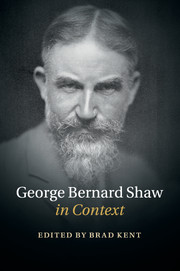Book contents
- Frontmatter
- Dedication
- Contents
- List of illustrations
- Notes on contributors
- Preface
- Acknowledgements
- A Chronology of Shaw's Works
- List of abbreviations
- PART I PEOPLE AND PLACES
- PART II THEATRE
- 7 The Abbey Theatre
- 8 Actors and actresses
- 9 The Court Theatre
- 10 Fabian drama
- 11 Farcical comedy
- 12 History plays
- 13 Melodrama
- 14 The New Drama
- PART III WRITING AND THE ARTS
- PART IV POLITICS
- PART V CULTURE AND SOCIETY
- PART VI RECEPTION AND AFTERLIFE
- Further reading
- Index
- References
8 - Actors and actresses
from PART II - THEATRE
Published online by Cambridge University Press: 05 October 2015
- Frontmatter
- Dedication
- Contents
- List of illustrations
- Notes on contributors
- Preface
- Acknowledgements
- A Chronology of Shaw's Works
- List of abbreviations
- PART I PEOPLE AND PLACES
- PART II THEATRE
- 7 The Abbey Theatre
- 8 Actors and actresses
- 9 The Court Theatre
- 10 Fabian drama
- 11 Farcical comedy
- 12 History plays
- 13 Melodrama
- 14 The New Drama
- PART III WRITING AND THE ARTS
- PART IV POLITICS
- PART V CULTURE AND SOCIETY
- PART VI RECEPTION AND AFTERLIFE
- Further reading
- Index
- References
Summary
No playwright has exercised more power over the casting of his plays than Bernard Shaw. Between the writing of Widowers’ Houses and Buoyant Billions, he spent millions of words wooing, bullying, flattering, and personally coaching actors he tagged for his plays. Shaw needed to verbally dominate: words were his life; words were creative power – ‘And God said, Let there be light: and there was light’. If four words could create a universe, millions of words might do – what? He also craved beauty. ‘Anybody can be tragic if they are born so, but that every stroke shall be beautiful as well as powerful, beautiful to the eye and ear; that is what I call art’ (CL I: 338).
Shaw's letter to the English actress Eleanor Robson, for whom he had written Major Barbara, is Shaw the wooer of art at full tide: ‘I intended that you should play Barbara for me … I see you in the part; I love you in the part; I was inspired to write the part so that when the Word became Flesh (these old religious catch words are the plainest common sense to me) the flesh should be yours’ (CL II: 586–90). Contradictorily, ‘the vile body’ repelled him.
With Ellen Terry, England's leading actress since she joined Henry Irving's Lyceum Theatre in 1878, Shaw's dilemma peaked. He made rhapsodic love to her on paper for years; wanted to escape to a corner of heaven where she could rock and nurse him on her bosom; yet was terrified to meet her in the flesh, a fear he projected onto Ellen: ‘Only, do as you have hitherto done with so wise an instinct: keep out of my reach’ (CL I: 677). But Terry did not object to meeting Shaw. As her great-nephew, Sir John Gielgud observed, ‘All Terrys were sensualists’.
For two years Shaw coaxed Terry to persuade Henry Irving, her acting and sexual partner and the first actor knighted for his exceptional service to the theatre, to stage his Man of Destiny. When the play remained on Irving's shelf, he teased her with Candida. Finally, Shaw wrote her a play, but when, in 1906, Terry did incarnate Lady Cicely in Captain Brassbound's Conversion, her memory was so poor that Shaw had to teach her her part and then hear his words get short shrift.
- Type
- Chapter
- Information
- George Bernard Shaw in Context , pp. 61 - 67Publisher: Cambridge University PressPrint publication year: 2015

